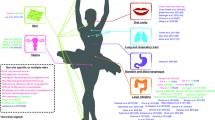Abstract
The field of metagenomics (study of a system’s microbiome) comes with various questions researchers are called to answer. Questions about the microbiota’s identity, the interactions of the participating bacteria, fungi, and viruses and their associations with health and disease. Nowadays, the answers to these questions are revealed via next-generation sequencing (NGS) and bioinformatics pipelines. NGS has allowed us to study even the unculturable microbiota whereas the development of appropriate in silico methodologies has made analyzing them fast, accurate, and accessible.
Access this chapter
Tax calculation will be finalised at checkout
Purchases are for personal use only
Similar content being viewed by others
References
Allard G, et al. SPINGO: a rapid species-classifier for microbial amplicon sequences. BMC Bioinformatics. 2015;16(1):324.
Alneberg J, et al. Binning metagenomic contigs by coverage and composition. Nat Methods. 2014;11(11):1144–6.
Bolyen E, et al. Reproducible, interactive, scalable and extensible microbiome data science using QIIME 2. Nat Biotechnol. 2019;37(8):852–7.
D’Amore R, et al. A comprehensive benchmarking study of protocols and sequencing platforms for 16S rRNA community profiling. BMC Genomics. 2016;17(1):55.
Davenport M, et al. Metabolic alterations to the mucosal microbiota in inflammatory bowel disease. Inflamm Bowel Dis. 2014;20(4):723–31.
DeSantis TZ, et al. Greengenes, a chimera-checked 16S rRNA gene database and workbench compatible with ARB. Appl Environ Microbiol. 2006;72(7):5069–72.
Dhariwal A, et al. MicrobiomeAnalyst: a web-based tool for comprehensive statistical, visual and meta-analysis of microbiome data. Nucleic Acids Res. 2017;45(W1):W180–8.
Edgar RC. UPARSE: highly accurate OTU sequences from microbial amplicon reads. Nat Methods. 2013;10(10):996–8.
Flygare S, et al. Taxonomer: an interactive metagenomics analysis portal for universal pathogen detection and host mRNA expression profiling. Genome Biol. 2016;17(1):111.
Fu L, et al. CD-HIT: accelerated for clustering the next-generation sequencing data. Bioinformatics. 2012;28(23):3150–2.
Huson DH, Weber N. Microbial community analysis using MEGAN. Methods Enzymol. 2012;531:465–85.
Iwai S, et al. Piphillin: improved prediction of metagenomic content by direct inference from human microbiomes. PLoS One. 2016;11(11):e0166104.
Kang DD, et al. MetaBAT, an efficient tool for accurately reconstructing single genomes from complex microbial communities. PeerJ. 2015;3:e1165.
Le Cao K-A, et al. mixMC: a multivariate statistical framework to gain insight into Microbial Communities. PLoS One. 2016;11(8):e0160169.
Mendes-Soares H, et al. MMinte: an application for predicting metabolic interactions among the microbial species in a community. BMC Bioinformatics. 2016;17(1):343.
Minich JJ, et al. High-throughput miniaturized 16S rRNA amplicon library preparation reduces costs while preserving microbiome integrity. MSystems. 2018;3(6):e00166–18.
Petersen TN, et al. MGmapper: reference based mapping and taxonomy annotation of metagenomics sequence reads. PLoS One. 2017;12(5):e0176469.
Pruesse E, et al. SILVA: a comprehensive online resource for quality checked and aligned ribosomal RNA sequence data compatible with ARB. Nucleic Acids Res. 2007;35(21):7188–96.
Pruitt KD, Tatusova T, Maglott DR. NCBI reference sequences (RefSeq): a curated non-redundant sequence database of genomes, transcripts and proteins. Nucleic Acids Res. 2007;35(suppl_1):D61–5.
Rintala A, et al. Gut microbiota analysis results are highly dependent on the 16S rRNA gene target region, whereas the impact of DNA extraction is minor. J Biomol Technol. 2017;28(1):19.
Salipante SJ, et al. Performance comparison of Illumina and ion torrent next-generation sequencing platforms for 16S rRNA-based bacterial community profiling. Appl Environ Microbiol. 2014;80(24):7583–91.
Schloss PD, et al. Introducing mothur: open-source, platform-independent, community-supported software for describing and comparing microbial communities. Appl Environ Microbiol. 2009;75(23):7537–41.
Segata N, et al. Metagenomic biomarker discovery and explanation. Genome Biol. 2011;12(6):R60.
Segata N, et al. Metagenomic microbial community profiling using unique clade-specific marker genes. Nat Methods. 2012;9(8):811–4.
Shannon P, et al. Cytoscape: a software environment for integrated models of biomolecular interaction networks. Genome Res. 2003;13(11):2498–504.
Ter Braak CJ. Canonical correspondence analysis: a new eigenvector technique for multivariate direct gradient analysis. Ecology. 1986;67(5):1167–79.
Ulyantsev VI, et al. MetaFast: fast reference-free graph-based comparison of shotgun metagenomic data. Bioinformatics. 2016;32:btw312.
Yang Y, Chen N, Chen T. Inference of environmental factor-microbe and microbe-microbe associations from metagenomic data using a hierarchical Bayesian statistical model. Cell Syst. 2017;4(1):129–137.e5.
Zakrzewski M, et al. Calypso: a user-friendly web-server for mining and visualizing microbiome–environment interactions. Bioinformatics. 2017;33(5):782–3.
Author information
Authors and Affiliations
Corresponding author
Editor information
Editors and Affiliations
Rights and permissions
Copyright information
© 2021 Springer Nature Switzerland AG
About this chapter
Cite this chapter
Dovrolis, N. (2021). In Silico Metagenomics Analysis. In: Gazouli, M., Theodoropoulos, G. (eds) Gut Microbiome-Related Diseases and Therapies. The Microbiomes of Humans, Animals, Plants, and the Environment, vol 1. Springer, Cham. https://doi.org/10.1007/978-3-030-59642-2_2
Download citation
DOI: https://doi.org/10.1007/978-3-030-59642-2_2
Published:
Publisher Name: Springer, Cham
Print ISBN: 978-3-030-59641-5
Online ISBN: 978-3-030-59642-2
eBook Packages: Biomedical and Life SciencesBiomedical and Life Sciences (R0)




